Key takeaways:
- Selective mutism is a complex anxiety disorder characterized by an inability to speak in certain social situations, often rooted in fear and social anxiety.
- Building trust and fostering a supportive environment can help individuals with selective mutism feel more comfortable speaking.
- Practical strategies such as small talk in low-pressure settings, using visual aids, and practicing active listening can enhance social interactions.
- Confidence can be built by sharing feelings, practicing positive self-talk, and setting small, achievable goals in social settings.
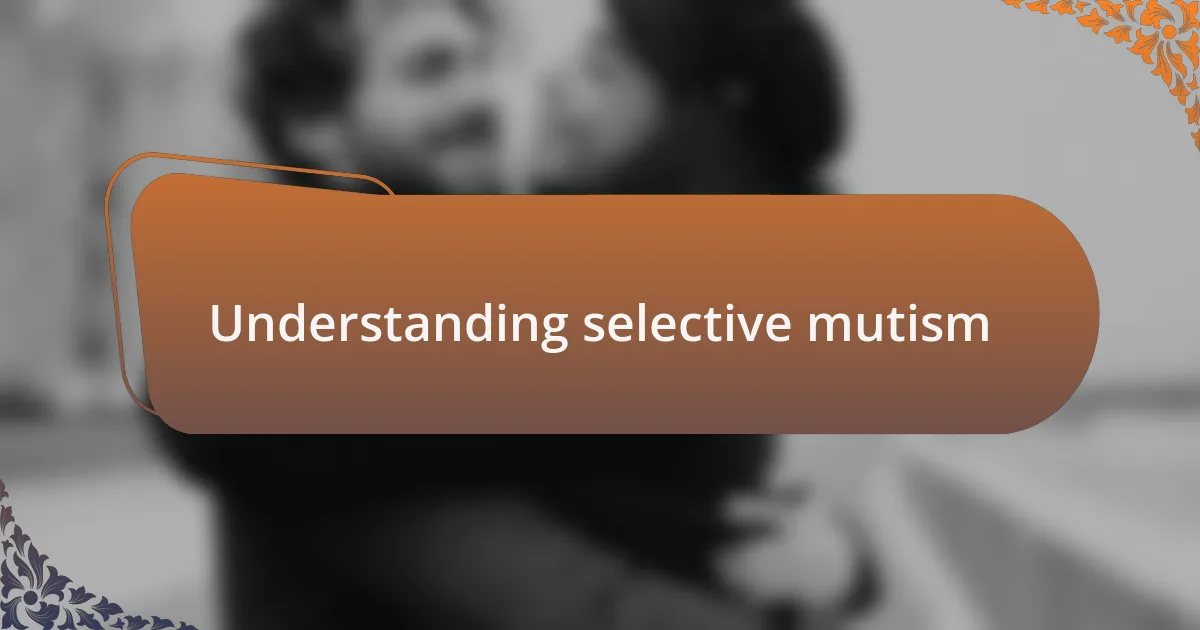
Understanding selective mutism
Selective mutism is more than just a reluctance to speak; it’s a complex anxiety disorder that can leave individuals feeling trapped in silence. I remember a time in school when I had so much to say but couldn’t voice any of it, even when my teachers encouraged me. Have you ever felt that tightness in your chest when you wanted to join in but couldn’t?
Understanding the root of selective mutism often reveals layers of fear and social anxiety. I once chatted with a friend who described it as a shadow that follows them into every gathering. They expressed feeling judged, as if everyone was waiting for them to speak, only intensifying their silence. How can we create a space where those experiencing this feel safe enough to break that silence?
In my experience, building trust with others can significantly ease the pressure of speaking up. I found that when people around me were genuinely patient and supportive, it made all the difference. Have you ever noticed how a simple smile can sometimes speak louder than words? It’s these small gestures that can pave the way for someone to find their voice in the midst of their struggles.
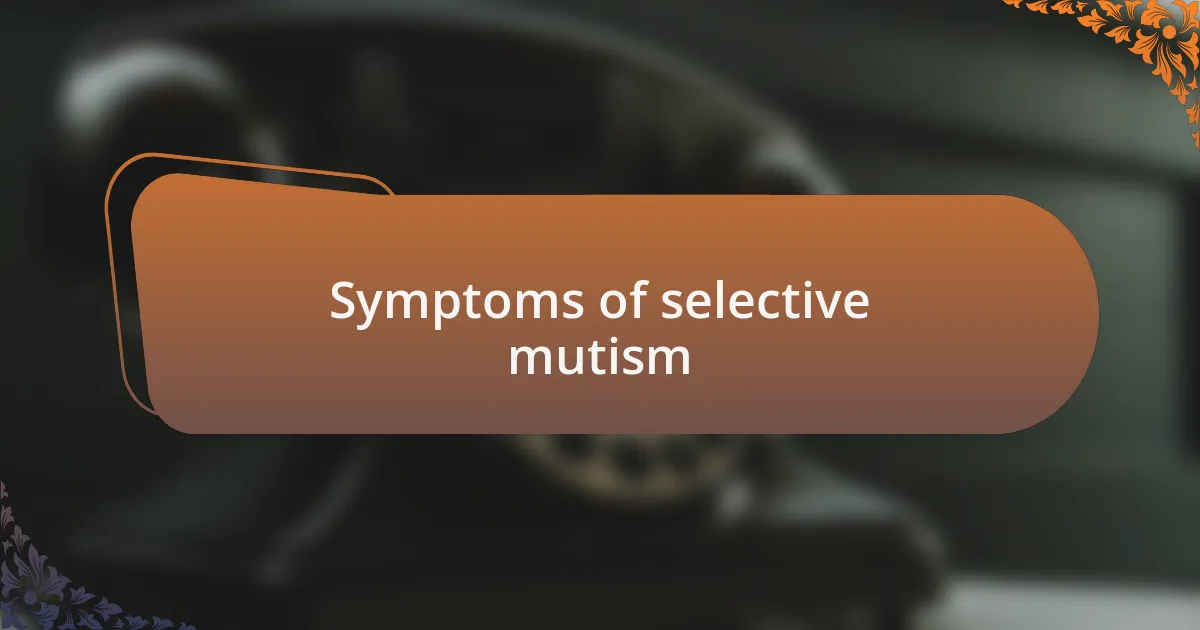
Symptoms of selective mutism
When it comes to selective mutism, symptoms often manifest in various social situations. For instance, I recall attending a family gathering where a loud, bustling environment made it nearly impossible for me to speak, even to those closest to me. That overwhelming sensation of being unable to form words, despite wanting to connect, is a common experience for many of us.
In addition to silence, individuals may also show signs of anxiety, such as avoiding eye contact or displaying physical signs like fidgeting or sweating. I remember sitting in a classroom, my heart racing as I noticed my palm growing clammy just at the thought of having to participate. How often do we underestimate the power of our body’s response to fear in these moments?
Another hallmark symptom is the inconsistency of speech. Many with selective mutism can speak comfortably in familiar settings but struggle in new environments. I find it fascinating yet frustrating how a simple change of scenery could turn my voice to a whisper, reminding me that the ambiance around us plays a crucial role in our ability to communicate. What experiences have made you feel similarly caught between wanting to speak up and the fear holding you back?

Importance of social situations
Social situations carry immense value in our lives, particularly for those of us with selective mutism. I remember a community event where everyone engaged in lively conversations; the air was filled with laughter and connection. Even from the sidelines, I felt an undeniable pull to join in, highlighting how these gatherings can stir a longing for social interaction despite the challenges that silence brings.
Navigating social settings is not just about speaking up; it’s also about building connections. There are times when I’ve found solace in observing others interact, feeling that silent understanding that we’re all in it together. Have you ever felt that sense of camaraderie in a crowded room, even when words eluded you? Those moments serve as a reminder of the importance of presence, reinforcing that connection often flows beyond verbal exchanges.
Moreover, social situations provide opportunities for personal growth and coping strategies. I once attended a workshop focused on communication skills, and it opened my eyes to different ways of expressing myself. Each small triumph in these settings, whether it meant a brave attempt at initiating conversation or simply exchanging smiles, contributed to my confidence and shaped my approach to future interactions.
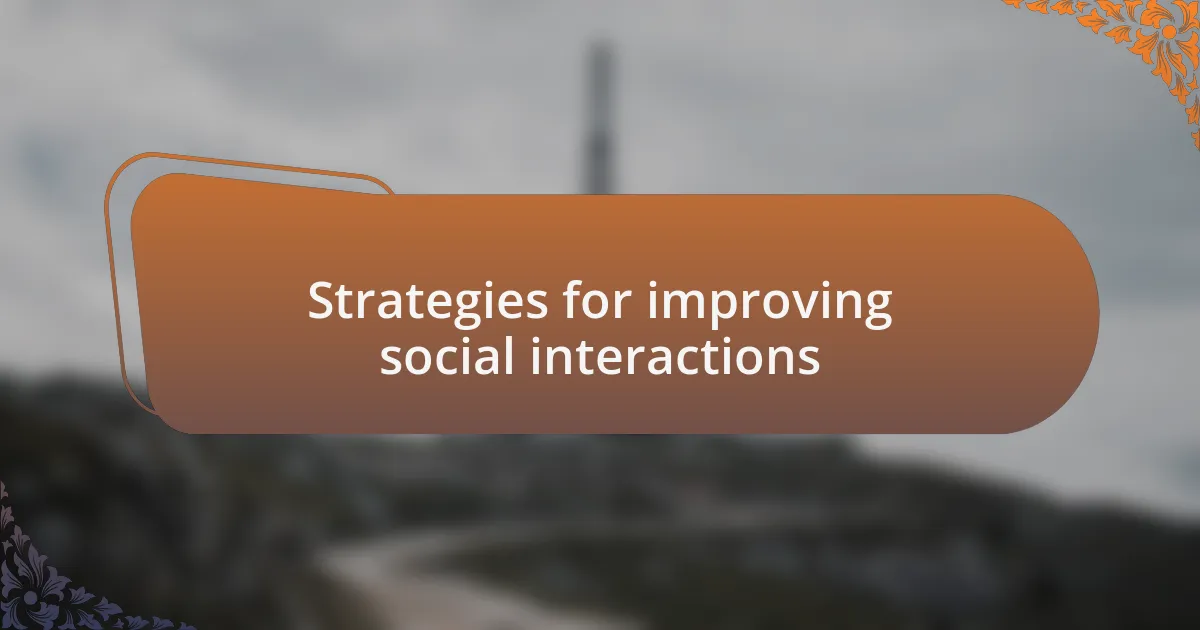
Strategies for improving social interactions
One effective strategy I’ve found is to practice small talk in low-pressure environments. I remember standing in line at a coffee shop, feeling my heart race as I leaned over to compliment the barista on their new hairstyle. That brief exchange, although nerve-wracking, not only broke the ice but also boosted my confidence for future interactions. Have you ever noticed how these small moments can turn into stepping stones toward greater communication?
Another approach that works for me is using visual aids or prompts in social situations. In one instance, I brought along a notebook filled with interesting topics and questions during a gathering. It served as both a conversation starter and a safety net, allowing me to feel prepared. How many times have you felt more assured with a few words to guide your engagement? This technique can make a significant difference in connecting without the pressure of spontaneous conversation.
Lastly, I’ve learned the immense value of active listening. Being attentive not only helps me stay engaged, but it also fosters a deeper connection with others. I vividly recall a time when I focused entirely on a friend’s story, nodding and encouraging them. Their enthusiasm ignited a spark in my own willingness to contribute, even if it’s just a few words. Have you ever felt that sense of engagement turn your silence into a shared moment? It’s these rich interactions that remind me how empowering it can be to listen intently.

Personal experiences with communication
When it comes to personal experiences with communication, I’ve found that my body language speaks volumes, even when my voice feels trapped. I recall attending a friend’s birthday party, where I felt overwhelmed by the crowd. Instead of verbalizing my discomfort, I focused on maintaining eye contact and smiling warmly at those around me. This subtle engagement helped ease my anxiety and encouraged others to approach me, proving that sometimes, non-verbal cues can bridge the gap of silence. Have you ever relied on gestures to convey your thoughts in a bustling environment?
There was a time during a team meeting when I felt frozen with anxiety, unable to vocalize my ideas. Rather than remaining silent, I decided to write my thoughts on sticky notes, which I then shared with the group. To my surprise, my colleagues responded positively, appreciating the clarity my notes provided. It was an eye-opener for me; I realized that communication doesn’t always have to occur through spoken words. Have you found alternative methods that allow you to express yourself when speaking feels daunting?
Reflecting on my journey, I see that humor has been a powerful tool for navigating social situations. I remember a gathering where I felt the pressure to engage but struggled to find the right words. In that moment, I shared a light-hearted story about my own misunderstandings in conversations, and laughter ensued. That shared humor broke down barriers and made others feel comfortable, transforming the atmosphere completely. Isn’t it fascinating how laughter can release tension and foster connections almost instantly?
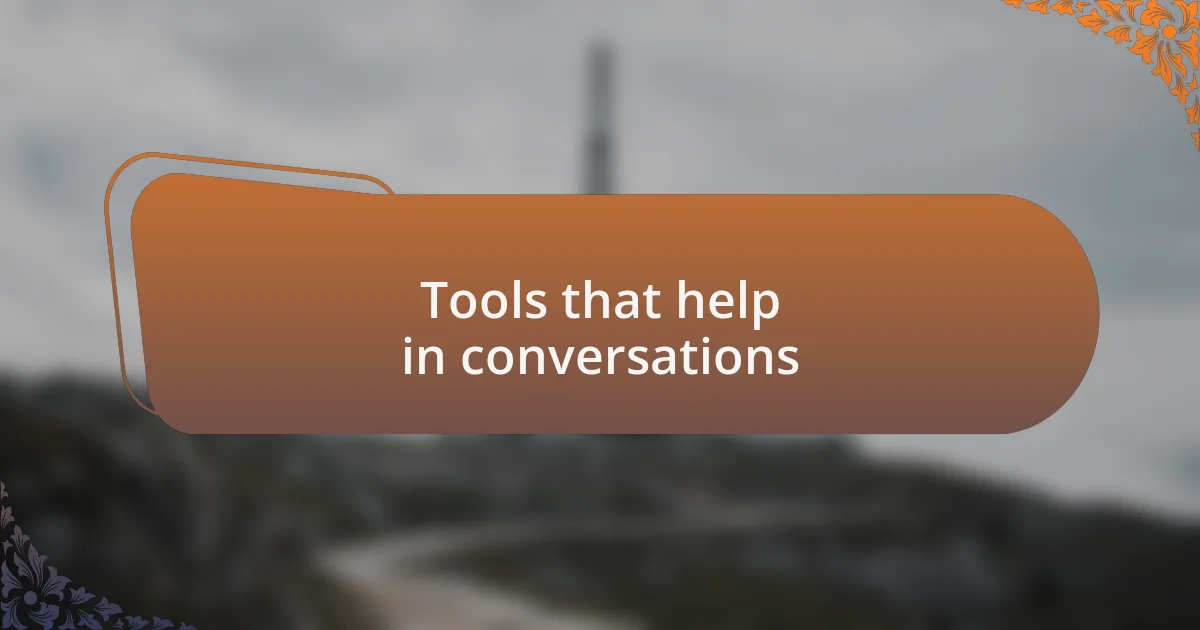
Tools that help in conversations
Using tools like note-taking can transform the way we communicate in social situations. I vividly remember an instance where I went to a networking event feeling completely overwhelmed. Instead of engaging in conversation, I brought a small notepad. When someone approached me, I jotted down a few prompts that highlighted my interests. This simple tool gave me something to reference, making the dialogue flow much smoother. Have you ever thought about how such a straightforward technique could help ease your nerves when speaking with new people?
While navigating social environments, I’ve also discovered the power of prepared questions. At a family reunion, I felt a wave of anxiety wash over me. To manage this, I prepared a list of open-ended questions prior to the event. I asked about everyone’s latest hobbies, which sparked genuine conversations. It felt rewarding to listen to their stories, and I noticed how it took the pressure off me to fill every silence with my own words. Do you think having a go-to list could make conversations feel less daunting for you?
Lastly, I find that using technology can enhance conversations significantly. There have been moments when I felt anxious during group chats; in those times, utilizing a messaging app to communicate my thoughts rather than speaking up has been a game-changer for me. During a seminar, I typed my questions in the app instead of raising my hand, which allowed me to participate fully without the fear of stumbling over my words. It struck me how much technology could serve as a bridge in social interactions. Have you ever used tech to communicate when words felt so far from reach?
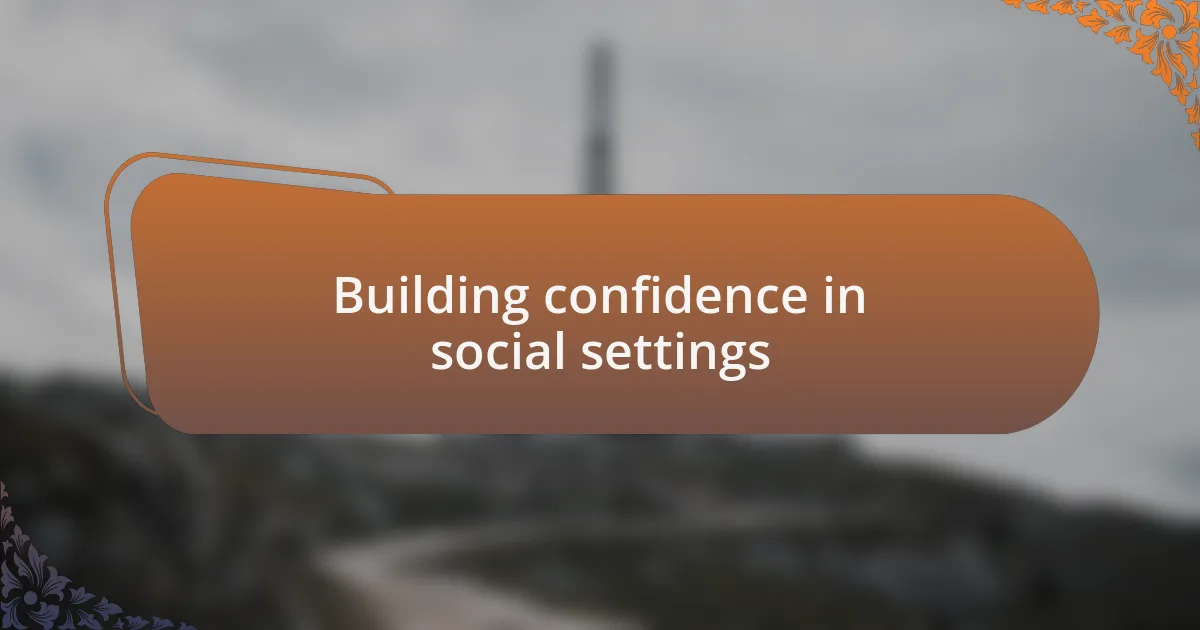
Building confidence in social settings
Finding ways to build confidence in social settings can be a transformative experience. I recall attending a workshop where I was encouraged to share my feelings of discomfort openly. By expressing my anxiety about social interactions to the group, I discovered that many others felt the same way. This moment of vulnerability not only lightened my anxiety but also fostered a sense of connection, reminding me that I was not alone in my struggles. Have you ever thought about how sharing your feelings could build a network of support?
Practicing positive self-talk has also been a game changer for me. On one occasion, before a casual get-together, I stood in front of the mirror and reminded myself of my strengths and the enjoyable qualities I brought to conversations. This simple exercise increased my self-assurance and set a positive tone for the evening. I couldn’t help but wonder how shifting our internal dialogue might change our interactions. Have you considered what messages you tell yourself before entering a social situation?
Another powerful strategy I’ve utilized is setting small, achievable goals for each social outing. I vividly remember going to a birthday party and deciding that I would aim to initiate at least one conversation. Just having that goal in mind made it easier for me to approach someone and start chatting. I felt a sense of accomplishment when I not only met my goal but also made a new friend. Doesn’t it feel refreshing to focus on small victories while building your confidence?